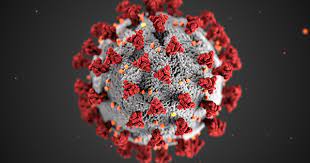Sandbox Reserved 1736
From Proteopedia
| Line 1: | Line 1: | ||
[[Image:Covid image.jpg]] | [[Image:Covid image.jpg]] | ||
| - | |||
| - | |||
| - | |||
| - | |||
| - | |||
| - | |||
| - | |||
| - | |||
==SARS-CoV-2 Spike Protein== | ==SARS-CoV-2 Spike Protein== | ||
The SARS-CoV-2 spike protein (Severe acute respiratory syndrome coronavirus 2) is a protein that has emerged from the COVID-19 virus beginning in December 2019. Both the S1 and S2 subunits are the last two regions that manage the processes of the receptor binding and the membrane fusing. | The SARS-CoV-2 spike protein (Severe acute respiratory syndrome coronavirus 2) is a protein that has emerged from the COVID-19 virus beginning in December 2019. Both the S1 and S2 subunits are the last two regions that manage the processes of the receptor binding and the membrane fusing. | ||
Revision as of 01:09, 8 November 2022
Contents |
SARS-CoV-2 Spike Protein
The SARS-CoV-2 spike protein (Severe acute respiratory syndrome coronavirus 2) is a protein that has emerged from the COVID-19 virus beginning in December 2019. Both the S1 and S2 subunits are the last two regions that manage the processes of the receptor binding and the membrane fusing. In the S1 subunit, it is composed of an N-terminal, receptor-binding domain, and the fusion of peptides, heptapeptide 1 and 2, TM domain, and cytoplasmic domain fusion are the reason for viral fusion and entry. In the S2 subunit, the S-protein trimers have a shape of a crown-like looking halo that is on the surrounding area of the viral particle. Because of the structure of the coronavirus S protein monomers this causes both the S1 and S2 subunits to be formulated into a “bulbous head and stalk region”. In the native state– the protein is folded to be able to operate and function properly. In this case the SARS-CoV-2 spike protein begins to exist as an inactive precursor when in this specific state. However, in a viral infection state SARS-CoV-2 spike protein the target cell's proteases will activate the S-protein which is being cleaved into both the S1 and S2 subunits. As a result, this allows for the activation of the membrane fusion after the result of viral entry are in the targeted cells.[1]
Function
The SARS-CoV-2 spike protein helps extract antibodies that neutralize viruses into the body. To enter a cell and start an infection, the spike protein in SARS-CoV-2 (SARS-2-S) interacts with the human ACE2 receptor. The ACE2 (Angiotensin-converting enzyme 2) is an enzyme that can be found in the membrane of cells in the following: intestines, kidney, testis, gallbladder, and heart. The SARS-2-S is split into S1 and S2 subunits, with S1 functioning as the receptor-binding component and S2 as the membrane-fusion subunit.[2]
Disease
The SARS-CoV-2 virus causes an infectious disease called Coronavirus (COVID-19). Coronavirus emerged in December of 2019. Most people infected with the disease experience an array of symptoms including fever, headaches, fatigue, sore throat, cough, etc. The spike protein is on the surface of the SARS-CoV-2 virus which then initiate infection in host cells.[3]
Mutations
The viral DNA experiences numerous spike protein changes to enable it to infect a new mammalian host and leap species. The D614G mutation is known to boost the effectiveness of infection and is said to be substantially more common in the spike protein. Drugs created to target protein-protein interactions, such as vaccines, may be affected by mutations found at the interface between the ACE2 receptor and the spike protein. [4]
Structural Highlights
The SARS-CoV-2 spike protein has a primary, secondary, tertiary, and quaternary structure. The Primary structure of the SARS-CoV-2 spike protein is composed of 1,273 amino acids linked together to form a polypeptide chain. The interactions of these polypeptides, or the secondary structure, consists: five Beta-sheets, three alpha helices, and B-turns. The 3-D form of the protein plays a role in receptor recognition cell membrane fusion process that has two subunits: S1 and S2. The Angiotensin-converting enzyme 2 is recognized and bound by the receptor-binding domain of the S1 subunit. Through the two-heptad repeat domain, the S2 subunit facilitates viral cell membrane fusion, resulting in a six helical bundle. [1]
This is a sample scene created with SAT to by Group, and another to make of the protein. You can make your own scenes on SAT starting from scratch or loading and editing one of these sample scenes.
</StructureSection>
References
- ↑ 1.0 1.1 Huang, Y.; Yang, C.; Xu, X.-feng; Xu, W.; Liu, S.-wen. Structural and Functional Properties of SARS-COV-2 Spike Protein: Potential Antivirus Drug Development for Covid-19. Acta Pharmacologica Sinica 2020, 41 (9), 1141–1149.
- ↑ Xia, X. Domains and Functions of Spike Protein in SARS-COV-2 in the Context of Vaccine Design. Viruses 2021, 13(1).
- ↑ Bangaru, S.; Ozorowski, G.; Turner, H. L.; Antanasijevic, A.; Huang, D.; Wang, X.; Torres, J. L.; Diedrich, J. K.; Tian, J.-H.; Portnoff, A. D.; Patel, N.; Massare, M. J.; Yates, J. R.; Nemazee, D.; Paulson, J. C.; Glenn, G.; Smith, G.; Ward, A. B. Structural Analysis of Full-Length SARS-COV-2 Spike Protein from an Advanced Vaccine Candidate. Science 2020, 370 (6520), 1089–1094.
- ↑ Guruprasad, L. Human Sars-CoV‐2 Spike Protein Mutations. Proteins: Structure, Function, and Bioinformatics 2021, 89 (5), 569–576.

